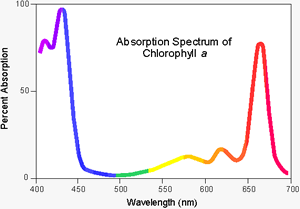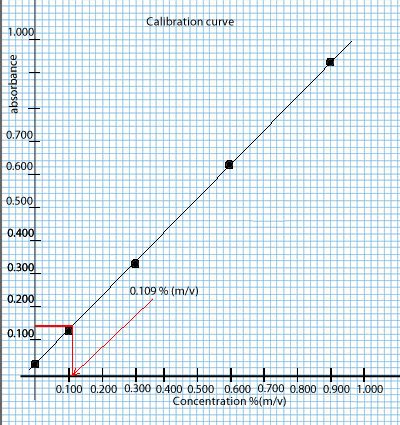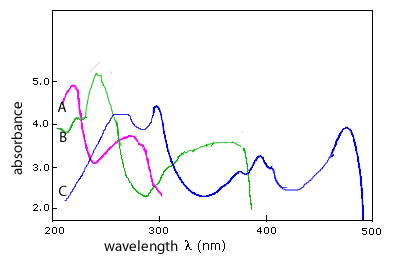This analytical technique uses the fact that valence electrons, be they bonding or non-bonding, may absorb electromagnetic radiation in the UV-visible region. Once electrons absorb such wavelengths they are promoted into higher energy levels. Different substances have different energy levels which electrons can be excited into. UV-visible spectroscopy measures the amount of energy an electron absorbs as it jumps from ground state to an excited state.
This technique can be used for qualitative and quantitative purposes. We can use this technique to identify the molecule or atom being analysed and can also be used to measure concentration levels of a particular substance. When a substance absorbs radiation from the visible spectrum it appears coloured. Take chlorophyll for example, it is present in plants and gives a rich green colour. Dilute solutions are prepared so as to allow a significant amount of light to pass through the solution and be measured by the recorder. Substances whose absorption is very large may have to be diluted in order for significant light to reach the recorder. Opaque solutions such as milk must also be diluted so that light can actually pass through and be recorded.


A simple UV-visible setup consists of a light source, a monochromator that selects the right wavelength of light, a transparent container that stores the sample and a detector.
Light coming from the monochromator is split into two beams, the reference beam that passes straight through to the detector and the beam of light that passes through the sample. The intensity of the reference beam is taken as 100% and the intensity of the beam passing through the sample is compared to the reference beam to determine the absorbance of the sample.

A more involved UV-visible spectrometer involves the use of a reference cell. Much like the infrared spectrophotometer the sample cell is placed next to a reference cell. The reference cell contains only solvent and is made of the same material as the sample cell. In effect it is used to zero the instrument, compensating for any absorption or reflection of light by the cell and solvent.

Before we make any measurements the instrument must be calibrated using a set of solutions of accurately known concentration, known as standard solutions. The absorbance of each standard solution is recorded and plotted on a graph known as the calibration curve.
Calibration curves are used to obtain the concentration of our unknown sample once the absorbance is known.
1) UV-visible spectroscopy measures the amount of
2) UV-visible spectroscopy is a technique that measure energy
3) When calibrating the equipment to be used we must first
4) Several standard solutions of the compound or substance in question are prepared before the unknown sample is analysed. Why?
5) The amount of calcium is to be analysed in a sample of milk imported from a a contaminated source. The sample must first be diluted before it can be analysed in a UV-visible spectrometer. This is because the original sample
6) The reference beam of light
7) Standard solutions are solutions
8) A calibration curve
9) Intensely absorbing compounds are examined in a UV-visible spectrometer only as dilute solutions. This is so that light

10) Which comments are true?
a) Substance B absorbs strongly at 290
b) A wavelength of 490 is best used to derive the concentration of C in a solution.
c) A wavelength of 210 is ideal for measuring the concentration of A, B and C in solution.